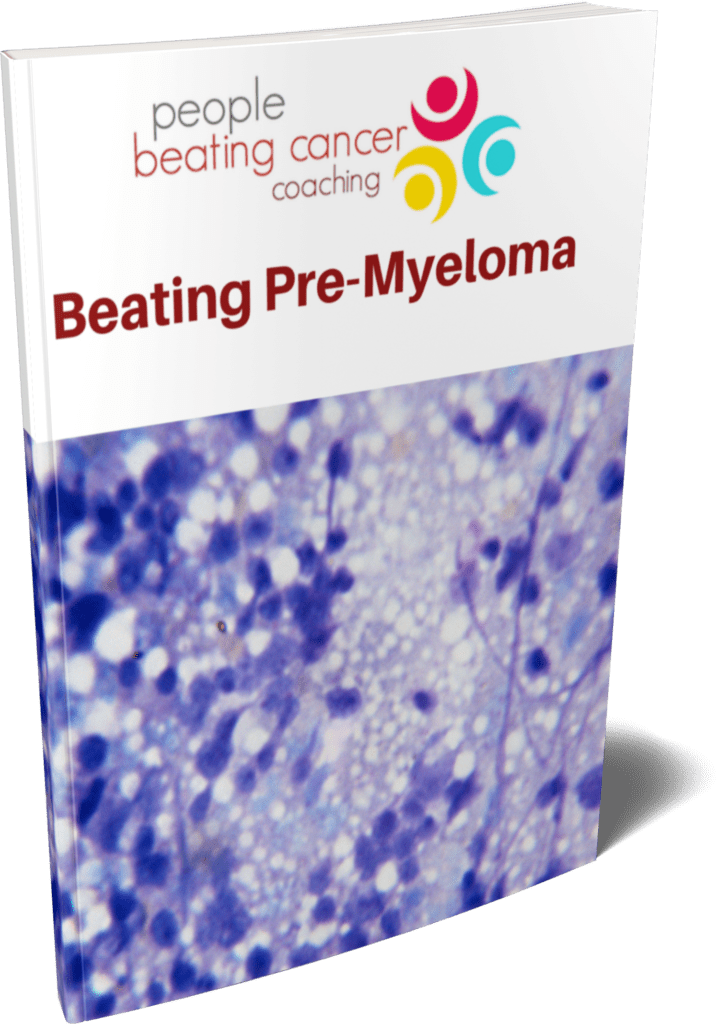
Diagnosed with SMM, SPB, or MGUS?
Learn how you can stall the development of full-blown Multiple Myeloma with evidence-based nutritional and supplementation therapies.
Click the orange button to the right to learn more.
- You are here:
- Home »
- Blog »
- Pre-Myeloma »
- MGUS Cure?
MGUS Cure?

Is an MGUS cure possible? According to the research linked and excerpted below, the answer is yes. Unfortunately, like most therapies for any form of monoclonal gammopathy such as:
- single plasmacytoma of bone-
- monoclonal gammopathy of undermined signifiance-
- smoldering multiple myeloma-
Rather than an MGUS cure or completely normal diagnostic testing numbers, I think the issue is response to therapy- curcumin and many others.
In the case discussed below, a number of MGUS patient’s responded to curcumin therapy as evidenced by reductions in their freelight chains and serum protein.
What non-conventional therapies support the MGUS patient?
- Nutritional Therapy: A balanced diet rich in nutrients can support overall health and potentially aid in managing MGUS. Some evidence suggests that certain dietary components, such as curcumin (found in turmeric), omega-3 fatty acids, and green tea, may have anti-inflammatory and immunomodulatory effects that could be beneficial.
- Mind-Body Practices: Techniques like yoga, meditation, and deep breathing exercises can help reduce stress, improve overall well-being, and support the immune system. Stress reduction is particularly important because stress can exacerbate inflammation and impact immune function.
- Acupuncture: Some MGUS patients find relief from symptoms such as pain and fatigue through acupuncture. While the mechanisms are not fully understood, acupuncture is thought to stimulate the body’s natural healing processes and promote balance within the body.
- Herbal Medicine: Certain herbs and supplements may have immune-modulating or anti-inflammatory properties that could potentially benefit MGUS patients. However, it’s crucial to consult with a qualified healthcare provider before using any herbal remedies, as they can interact with medications or exacerbate certain health conditions.
- Physical Therapy and Exercise: Exercise can help improve circulation, strengthen muscles, and boost overall health. Physical therapy may be particularly beneficial for MGUS patients experiencing musculoskeletal symptoms or mobility issues.
- Massage Therapy: Massage can help relieve muscle tension, improve circulation, and promote relaxation. Some MGUS patients find that regular massage sessions alleviate pain and improve their quality of life.
- Supportive Therapies: Joining a support group or participating in counseling or therapy sessions can provide emotional support, practical tips for managing symptoms, and a sense of community with others facing similar challenges.
When I was diagnosed with a single plasmacytoma of bone in 1994, my oncologist told me that there were no therapies for pre-myeloma. Since that time a number of non-conventional therapies such as curcumin, have been shown to be cytotoxic to plasma cells.
Further, the study below discusses a particularly challenging aspect of monoclonal gammopathies. Conventional oncology always defines MGUS as being asymptomatic. Yes, the study says that “MGUS is known to be associated with…” a number of symptoms. And then goes on to report that curcumin can help to manage these symptoms.
Fortunately, there are a number of nutritional supplements shown to
- enhance bone mineral density
- enhance kidney function
- even enhance heart health
Certainly an MGUS cure is everyone’s main goal. However, I guess my point is that while the study below cites an MGUS cure, my experience is about managing pre-myeloma aka SBP, MGUS and SMM. When I say “manage” I’m talking about Vincent Rajkumar’s Cure versus Control debate.
Curcumin combined with the non-toxic therapies outlined above, can control pre-myeloma providing therapies to those patients who, like me, are told that there are no therapies available for pre-myeloma.
Are you a newly diagnosed pre-myeloma patient? If you would like to learn more about managing pre-myeloma with evidence-based non-conventional therapies email me at David.PeopleBeatingCancer@gmail.com
Thank you,
David Emerson
- MM Survivor
- MM Cancer Coach
- Director PeopleBeatingCancer
Regression of Intermediate-High Risk Monoclonal Gammopathy of Undetermined Significance (MGUS) With Long-term Use of Curcumin: A Case Report
“Patients with intermediate-high risk MGUS are not offered therapeutic options to date and standard of care remains observation with re-evaluations of the patient every 3 to 6 months. Given the persistent risk of progression as well as potential complications experienced by some, and anxiety experienced by most patients, early intervention with non-toxic curcumin, aimed at potentially slowing down or stopping disease progression might be therapeutic.
We present here an intermediate-high risk MGUS patient who has been taking curcumin for 16 years and has shown a decrease in disease markers and an increase in uninvolved immunoglobulins, adding to the body of evidence of benefit of curcumin to MGUS patients…
Studies indicate that almost all cases of MM are preceded by the precursor state of MGUS.2 There are 3 subtypes of MGUS, namely,
- immunoglobulin M (IgM) MGUS,
- non-IgM MGUS,
- and light-chain MGUS,
each with distinct rate and type of progression.1
Although the risk of progression to MM or other LPMs is low (1% per year) for MGUS patients, it is still of considerable clinical importance because of its high prevalence in the general population and the persistent risk of progression.
In addition, MGUS is known to be associated with
- peripheral neuropathy,4
- monoclonal immunoglobulin deposition disease5
- and monoclonal gammopathy-associated proliferative glomerulonephritis.6
Some studies show that patients with MGUS may be at higher risk of osteoporosis and fractures and deep vein thrombosis.7,8 Several studies have shown that psychological distress including anxiety and stress suffered by MGUS patients is no less than it is for patients with active disease…9
Curcumin has been shown to inhibit the proliferation and induce apoptosis of multiple myeloma cells through the downregulation of IL-6 and NF-kB.12 Curcumin has also been shown to inhibit osteoclastogenesis and to reduce bone turnover through the suppression of RANKL signaling.13…
Based on its antimyeloma cell activity, we have performed a number of clinical studies with curcumin in MGUS and SMM patients, including a randomized, double-blind, placebo-controlled cross over study in 25 MGUS and SMM patients utilizing a 4 g dose of curcumin with cross over at 3 months followed by an 8 g extension study,
which demonstrated
- a statistically significant decrease in the free kappa to free lambda light chain ratio (rFLC, −35% and −36% for 4 and 8 g dose)
- and non-statistically significant reduction in involved free light chain, (iFLC, −8% and −10% for 4 and 8 g dose).14
- Statistically significant reductions in total serum and random urinary protein concentrations were also seen.
Updated results from long-term follow up of 13 MGUS and SMM patients taking curcumin (4-8 g daily) for 3 to 9 years, of their own volition, showed a change in monoclonal protein (decrease in 5, slight increase in 3 and rest stable), bone marrow plasma cells (decrease in 4, increase in 2, and rest stable) and reduction in free light chain ratio in 3 patients.15
According to the Mayo Clinic risk stratification model,1 an intermediate-high risk MGUS patient is defined by
- a monoclonal protein ≥1.5 g/dL,
- and an abnormal FLC ratio that is, 2 (of 3) risk factors.


